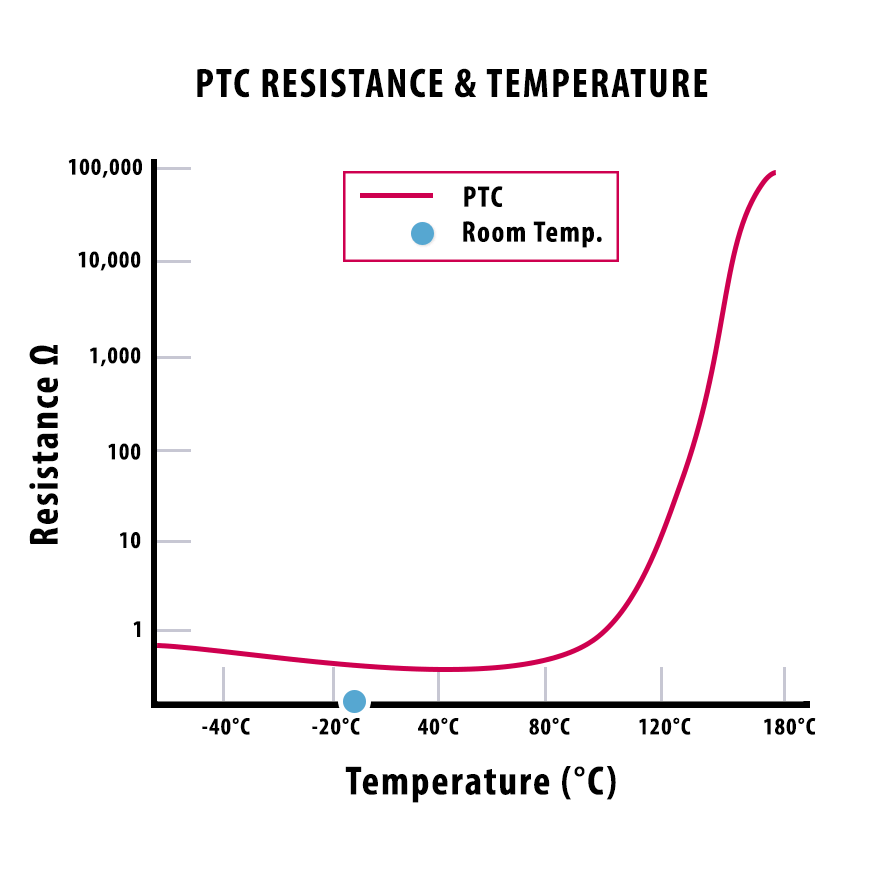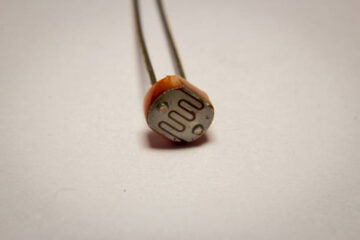So recently, my brother wrote a post about NTC thermistors supposedly being superior to their PTC counterpart. Of course, I cannot possibly condone such spread of misinformation, which is why I’ll now make a case for my beloved PTC, and why it’s the best thermistor.
Ok, so what are PTC thermistors?
PTC thermistors are resistors that increase their resistance when their temperature increases. This means that they have a Positive Temperature Coefficient with respect to their resistance; hence the acronym PTC.
All types of PTCs share the same symbol, depending on what standerd you use. Both the ANSI standard (for Americans 🦅🍔), and the normal IEC standard symbols are given below:
Variety is the spice of life, and PTCs (as opposed to NTCs) give plenty of choice. There exist four main types of PTCs, each with their own properties to suit their needs:
- Silicon-based PTCs
- Metal-based PTCs
- Ceramic-based PTCs
- Polymer-based PTCs
They all work a bit differently, so we’ll go over them one by one.
Silicon-based PTCs
The silicon-based PTC, also called a silistor, simply increases its resistance (almost) linearly with the temperature. You could say that this PTC works the most like how a reverse NTC would, with the material. Now, attentive readers may note that silicon usually has a negative temperature coefficient, which is mostly true. Although all silicon acts like a semiconductor (explained in The NTC thermistor and absolute zero), when it is placed in a monocrystalline silicon carbide structure (mono-Si carbide), it actually has a reverse effect, changing silicon’s properties from an NTC semiconductor to a PTC semiconducting crystal Silicon carbide as a material for high temperature posistors.
Silicon-based PTCs work for temperatures below 150 °C, after which the crystal-like properties of the mono-Si carbide lose to the semiconducting properties, and it starts to behaves like an NTC once again. Before this point is reached, it will have a linear temperature coefficient caused by oscillation of the fixed carbon atoms in the crystal lattices increasing, making them impede the flow of electrons in a linear fashion. Remember: temperature is directly proportional to the mean kinetic energy of a system, in this case of carbon in the lattice. This maks it a useful thermistor for when you want to be able to control the resistance accurately with the temperature.
Once temperatures get high enough, the electrons will experience such strong tunnelling effects that these collisions won’t really matter anymore, making it more akin to how a normal semi-conductor behaves.
Metal-based PTCs
These are the most widely known PTCs, because they appear in regular ol’ conductive materials. When a conductor, like copper, heats up, the atoms inside of it will start to oscillate. This makes it harder for the conducting electrons to pass through the conduction medium, increasing the resistance linearly with the temperature.
Compared to usual PTCs, metal-based PTCs need temperatures that are too high to make them better than other alternatives, so they are not widely used as such components. The PTC-like properties are actually more of a hindrance when it comes to their use, because running high voltage through copper wires actually creates losses due to the temperature increase these voltages induce. Electrical engineers have to take into account this so called ‘copper loss’ when designing the infrastructure for our electricity.
Ceramic-based PTCs
The Ceramic-based PTC is the most widely used PTC, because of its sudden change in resistance when it hits a certain threshold temperature. This type of PTC conducts electricity normally for low temperatures, and then blocks current once the temperature gets high enough. The temperature at which the switch occurs can be slightly altered by the manufacturer, although the standard range is between 60 and 140 °C. This behaviour is demonstrated in the graph below:

This PTC is usually made from barium titanite (BaTiO3), which behaves in many ways like a semiconductor that has NTC properties. The ceramic has different grains (small crystals), that are all interconnected through grain-boundaries (creative name, I know). In 1971, Heywang described a model of the behaviour of barium titanate at these grain-boundaries (Semiconducting barium), where the grain-boundaries would form electrical back-to-back Schkotty barriers. These Schkotty barriers are electrical potentials that form around the boundaries when the temperature reaches the Curie point.
Basically, these Schkotty barriers are either there or they’re not, and the potentials repel electrons from passing through the grains, giving rise to the macroscopic properties of the Ceramic-based PTC. For more information on why Schkotty barriers are formed, I’d suggest you read ‘Electronic Materials: Principles and Applied Science’ by Y.M. Poplavko (chapter 10.4).
Polymer-based PTCs
The polymer-based PTC, also known as PTC rubber, is a material made from polydimethylsiloxane loaded with carbon nanoparticles that can conduct electricity. Basically, at low temperatures, the polymer is in a crystalline state where the carbon lies in nice, orderly chains that can conduct a current. Once the polymer heats up however, the structure slowly turns amorphous (shapeless and chaotic), so that it will become harder and harder to conduct a current. When it cools down again, it will regain its original state.
All things considered, polymer-based PTCs have a resistance that is squarely proportional to the temperature. This makes it near-impossible to conduct electricity once the temperature reaches a certain point. Where Silicon-based PTCs work well to regulate, polymer-based PTCs are an excellent choice for ensuring safety where conducting materials need to be used.
What are PTCs used for?
Now that we know the three main types of PTCs, I’ll discuss their awesome, top-tier use cases, that are way better than those of the NTC.
Fail-safe
Of course, current is the transfer of energy. This means that when current flows through a circuit, some of the energy will leak into it and thus heat it up. This can be quite the problem, especially when your appliance is very energy-intensive and heat-sensitive. To counteract this problem, PTCs can be implemented as a sort of fuse, making sure that the current will stop flowing once the temperature reaches a dangerously high level.
Here are some examples of devices that use PTCs as fail-safes:
- Computer components
- EV (electrical vehicle) heating systems
- Heater cores in cars
- Alarms and security devices for lightening protection
- Experimental circuits that are prone to overheating
Self-regulation
Besides fail-safes, PTCs can be used as a temperature control so that devices can self-regulate their temperature. Take, for example, a heating unit. If you want it to remain at a certain temperature, you can use a PTC to make sure that once a certain temperature is reached, the current will be brought back by the increase in resistance. This ensures that no more heat will be added. If the heater were to cool down, the resistance would decrease, and so the extra current would heat it back up again. You could regulate this device by use of an adjustable resistance (potentiometer).
Time-regulation
When something regards change in temperature, the time it takes to change is always an important factor. You really can’t expect it to be instant, so the time it takes to heat or cool the PTC can be used in some clever ways.
One of these ways is by use of a sort of clock. You could plug it into a device that you want to take some time to power up, like when you first need to wind up a motor. At first, the current will flow through towards the motor, but after some time, when the PTC has heated up, the electricity can be guided towards other parts, as the motor doesn’t need it anymore.
You could also have it be done in reverse; that you wait for something to get ready, and only then supply electricity to it. Take for example an aperture producing a loud sound. You’d want to have some time to warn people, so if you want to mechanically implement this feature, you could use a PTC that will only supply a voltage large enough to trigger the sound after it has heated up enough.
Scientific research
Lastly, PTCs, of course, can be used to do physics! Whether it is used because you want to make sure your circuit doesn’t overheat, or because you actually want to study the ways in which electrical properties change with changing temperature, they can be a great tool. Linear PTCs, like copper or mono-cSi, can easily be made to measure the temperature of your set-up, or they can be studied on their own.
Final remarks
Doing research for this post, I have found that there is little yet known about all of the properties of PTCs, making it quite difficult to optimise them when your not linked to the companies that research and develop them. They are, however, a very useful component that has gained my love through all of its unique quirks and applications. They are like a beacon, bathing me in the comforting light of protection, making sure that even the device I am writing this on stays safe despite all of the energy coursing through it.
And a safe and happy week to you as well!
Paul Stapel
Student
I’m an aspiring writer, teacher, wizard and physicist!



0 Comments